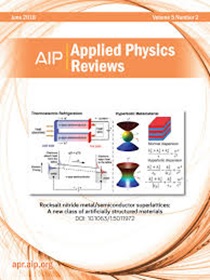缓解气候危机的微结构光学涂层
IF 11.6
1区 物理与天体物理
Q1 PHYSICS, APPLIED
引用次数: 0
摘要
面对全球能源和气候危机,多功能光学涂层已成为收集太阳能和降低能源消耗的关键。本文综述了基于几何光学原理设计的微结构光学涂层的最新进展,重点介绍了它们在能量收集和节能两个关键领域的作用。在第一类中,微结构表面通过改善阳光转向和捕获来提高光伏性能。在第二类中,它们通过在传输或反射太阳辐射的同时有效地以热辐射的形式发射热量来实现被动辐射冷却。与纳米结构涂层相比,微结构设计在大面积应用中具有明显的优势,包括与可扩展制造技术的兼容性以及精确的角度选择光学控制。该综述涵盖了水平(屋顶或地面安装)和垂直(建筑集成)配置,强调了每种配置如何需要专门的微观结构策略来应对不同的入射阳光条件和热管理挑战。通过对最先进的设计和材料的详细调查,本综述强调了微结构光学涂层在推进可持续能源技术方面的潜力,并深入了解了它们在缓解全球能源和气候危机方面的作用。本文章由计算机程序翻译,如有差异,请以英文原文为准。
Microstructured optical coatings for climate crisis mitigation
In the face of the global energy and climate crisis, multifunctional optical coatings have become crucial for harvesting solar energy and reducing energy consumption. This review examines recent developments in microstructured optical coatings designed based on geometric optics principles, highlighting their role in two key areas: energy harvesting and energy saving. In the first category, microstructured surfaces enhance photovoltaic performance through improved sunlight steering and capture. In the second category, they enable passive radiative cooling by efficiently emitting heat as thermal radiation while transmitting or reflecting solar radiation. Compared to nanostructured coatings, microstructured designs offer distinct advantages for large-area applications, including compatibility with scalable fabrication techniques and precise, angle-selective optical control. The review covers both horizontal (roof- or ground-mounted) and vertical (building-integrated) configurations, underscoring how each configuration demands specialized microstructural strategies to address different incident sunlight conditions and thermal management challenges. Through a detailed survey of state-of-the-art designs and materials, this review highlights the potential of microstructured optical coatings to advance sustainable energy technologies and gives insight into their role in mitigating global energy and climate crises.
求助全文
通过发布文献求助,成功后即可免费获取论文全文。
去求助
来源期刊

Applied physics reviews
PHYSICS, APPLIED-
CiteScore
22.50
自引率
2.00%
发文量
113
审稿时长
2 months
期刊介绍:
Applied Physics Reviews (APR) is a journal featuring articles on critical topics in experimental or theoretical research in applied physics and applications of physics to other scientific and engineering branches. The publication includes two main types of articles:
Original Research: These articles report on high-quality, novel research studies that are of significant interest to the applied physics community.
Reviews: Review articles in APR can either be authoritative and comprehensive assessments of established areas of applied physics or short, timely reviews of recent advances in established fields or emerging areas of applied physics.
 求助内容:
求助内容: 应助结果提醒方式:
应助结果提醒方式:


